Zhuowei Li
Token-Level Uncertainty Estimation for Large Language Model Reasoning
May 16, 2025Abstract:While Large Language Models (LLMs) have demonstrated impressive capabilities, their output quality remains inconsistent across various application scenarios, making it difficult to identify trustworthy responses, especially in complex tasks requiring multi-step reasoning. In this paper, we propose a token-level uncertainty estimation framework to enable LLMs to self-assess and self-improve their generation quality in mathematical reasoning. Specifically, we introduce low-rank random weight perturbation to LLM decoding, generating predictive distributions that we use to estimate token-level uncertainties. We then aggregate these uncertainties to reflect semantic uncertainty of the generated sequences. Experiments on mathematical reasoning datasets of varying difficulty demonstrate that our token-level uncertainty metrics strongly correlate with answer correctness and model robustness. Additionally, we explore using uncertainty to directly enhance the model's reasoning performance through multiple generations and the particle filtering algorithm. Our approach consistently outperforms existing uncertainty estimation methods, establishing effective uncertainty estimation as a valuable tool for both evaluating and improving reasoning generation in LLMs.
Optimal Transport-Guided Source-Free Adaptation for Face Anti-Spoofing
Mar 29, 2025Abstract:Developing a face anti-spoofing model that meets the security requirements of clients worldwide is challenging due to the domain gap between training datasets and diverse end-user test data. Moreover, for security and privacy reasons, it is undesirable for clients to share a large amount of their face data with service providers. In this work, we introduce a novel method in which the face anti-spoofing model can be adapted by the client itself to a target domain at test time using only a small sample of data while keeping model parameters and training data inaccessible to the client. Specifically, we develop a prototype-based base model and an optimal transport-guided adaptor that enables adaptation in either a lightweight training or training-free fashion, without updating base model's parameters. Furthermore, we propose geodesic mixup, an optimal transport-based synthesis method that generates augmented training data along the geodesic path between source prototypes and target data distribution. This allows training a lightweight classifier to effectively adapt to target-specific characteristics while retaining essential knowledge learned from the source domain. In cross-domain and cross-attack settings, compared with recent methods, our method achieves average relative improvements of 19.17% in HTER and 8.58% in AUC, respectively.
Show and Segment: Universal Medical Image Segmentation via In-Context Learning
Mar 25, 2025Abstract:Medical image segmentation remains challenging due to the vast diversity of anatomical structures, imaging modalities, and segmentation tasks. While deep learning has made significant advances, current approaches struggle to generalize as they require task-specific training or fine-tuning on unseen classes. We present Iris, a novel In-context Reference Image guided Segmentation framework that enables flexible adaptation to novel tasks through the use of reference examples without fine-tuning. At its core, Iris features a lightweight context task encoding module that distills task-specific information from reference context image-label pairs. This rich context embedding information is used to guide the segmentation of target objects. By decoupling task encoding from inference, Iris supports diverse strategies from one-shot inference and context example ensemble to object-level context example retrieval and in-context tuning. Through comprehensive evaluation across twelve datasets, we demonstrate that Iris performs strongly compared to task-specific models on in-distribution tasks. On seven held-out datasets, Iris shows superior generalization to out-of-distribution data and unseen classes. Further, Iris's task encoding module can automatically discover anatomical relationships across datasets and modalities, offering insights into medical objects without explicit anatomical supervision.
The Hidden Life of Tokens: Reducing Hallucination of Large Vision-Language Models via Visual Information Steering
Feb 05, 2025



Abstract:Large Vision-Language Models (LVLMs) can reason effectively over both textual and visual inputs, but they tend to hallucinate syntactically coherent yet visually ungrounded contents. In this paper, we investigate the internal dynamics of hallucination by examining the tokens logits rankings throughout the generation process, revealing three key patterns in how LVLMs process information: (1) gradual visual information loss -- visually grounded tokens gradually become less favored throughout generation, and (2) early excitation -- semantically meaningful tokens achieve peak activation in the layers earlier than the final layer. (3) hidden genuine information -- visually grounded tokens though not being eventually decided still retain relatively high rankings at inference. Based on these insights, we propose VISTA (Visual Information Steering with Token-logit Augmentation), a training-free inference-time intervention framework that reduces hallucination while promoting genuine information. VISTA works by combining two complementary approaches: reinforcing visual information in activation space and leveraging early layer activations to promote semantically meaningful decoding. Compared to existing methods, VISTA requires no external supervision and is applicable to various decoding strategies. Extensive experiments show that VISTA on average reduces hallucination by abount 40% on evaluated open-ended generation task, and it consistently outperforms existing methods on four benchmarks across four architectures under three decoding strategies.
MLLM-as-a-Judge for Image Safety without Human Labeling
Dec 31, 2024



Abstract:Image content safety has become a significant challenge with the rise of visual media on online platforms. Meanwhile, in the age of AI-generated content (AIGC), many image generation models are capable of producing harmful content, such as images containing sexual or violent material. Thus, it becomes crucial to identify such unsafe images based on established safety rules. Pre-trained Multimodal Large Language Models (MLLMs) offer potential in this regard, given their strong pattern recognition abilities. Existing approaches typically fine-tune MLLMs with human-labeled datasets, which however brings a series of drawbacks. First, relying on human annotators to label data following intricate and detailed guidelines is both expensive and labor-intensive. Furthermore, users of safety judgment systems may need to frequently update safety rules, making fine-tuning on human-based annotation more challenging. This raises the research question: Can we detect unsafe images by querying MLLMs in a zero-shot setting using a predefined safety constitution (a set of safety rules)? Our research showed that simply querying pre-trained MLLMs does not yield satisfactory results. This lack of effectiveness stems from factors such as the subjectivity of safety rules, the complexity of lengthy constitutions, and the inherent biases in the models. To address these challenges, we propose a MLLM-based method includes objectifying safety rules, assessing the relevance between rules and images, making quick judgments based on debiased token probabilities with logically complete yet simplified precondition chains for safety rules, and conducting more in-depth reasoning with cascaded chain-of-thought processes if necessary. Experiment results demonstrate that our method is highly effective for zero-shot image safety judgment tasks.
Implicit In-context Learning
May 23, 2024
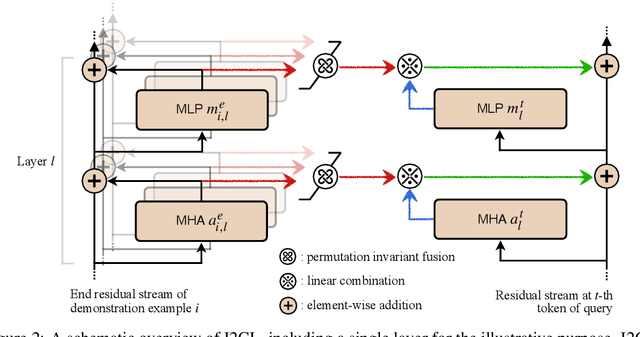


Abstract:In-context Learning (ICL) empowers large language models (LLMs) to adapt to unseen tasks during inference by prefixing a few demonstration examples prior to test queries. Despite its versatility, ICL incurs substantial computational and memory overheads compared to zero-shot learning and is susceptible to the selection and order of demonstration examples. In this work, we introduce Implicit In-context Learning (I2CL), an innovative paradigm that addresses the challenges associated with traditional ICL by absorbing demonstration examples within the activation space. I2CL first generates a condensed vector representation, namely a context vector, from the demonstration examples. It then integrates the context vector during inference by injecting a linear combination of the context vector and query activations into the model's residual streams. Empirical evaluation on nine real-world tasks across three model architectures demonstrates that I2CL achieves few-shot performance with zero-shot cost and exhibits robustness against the variation of demonstration examples. Furthermore, I2CL facilitates a novel representation of "task-ids", enhancing task similarity detection and enabling effective transfer learning. We provide a comprehensive analysis of I2CL, offering deeper insights into its mechanisms and broader implications for ICL. The source code is available at: https://github.com/LzVv123456/I2CL.
GAgent: An Adaptive Rigid-Soft Gripping Agent with Vision Language Models for Complex Lighting Environments
Mar 16, 2024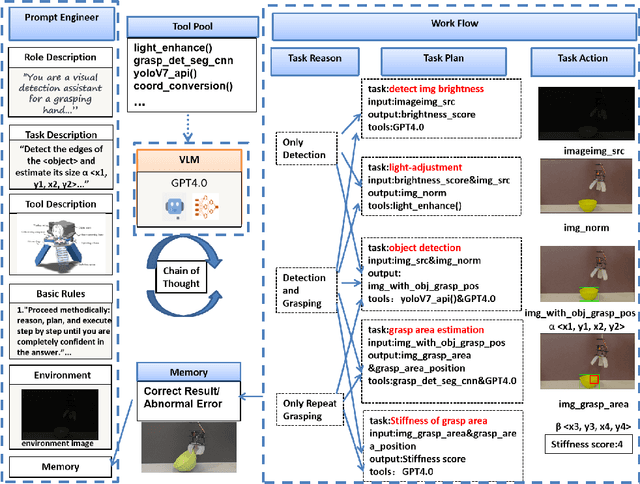

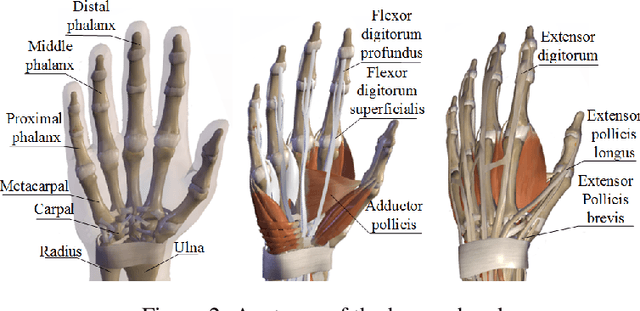
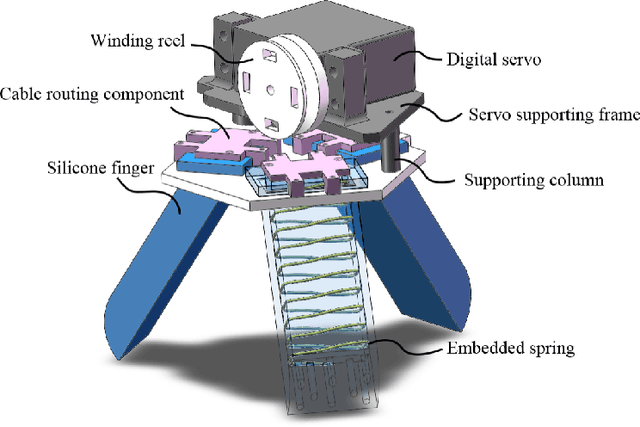
Abstract:This paper introduces GAgent: an Gripping Agent designed for open-world environments that provides advanced cognitive abilities via VLM agents and flexible grasping abilities with variable stiffness soft grippers. GAgent comprises three primary components - Prompt Engineer module, Visual-Language Model (VLM) core and Workflow module. These three modules enhance gripper success rates by recognizing objects and materials and accurately estimating grasp area even under challenging lighting conditions. As part of creativity, researchers also created a bionic hybrid soft gripper with variable stiffness capable of gripping heavy loads while still gently engaging objects. This intelligent agent, featuring VLM-based cognitive processing with bionic design, shows promise as it could potentially benefit UAVs in various scenarios.
DeFormer: Integrating Transformers with Deformable Models for 3D Shape Abstraction from a Single Image
Sep 22, 2023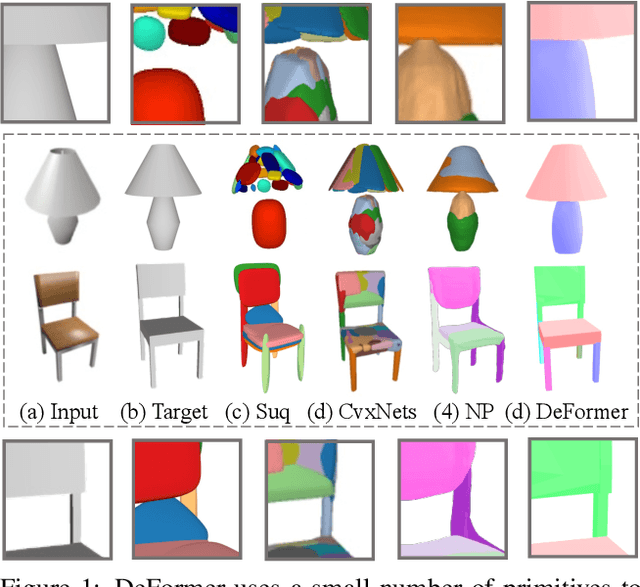

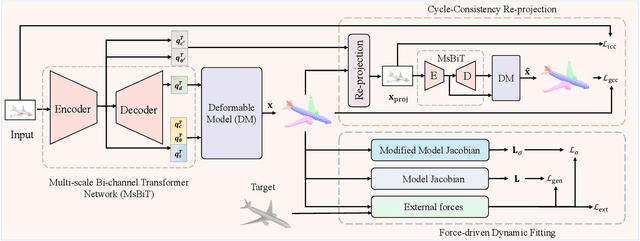
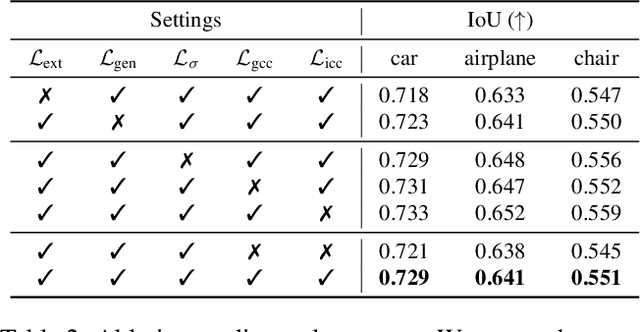
Abstract:Accurate 3D shape abstraction from a single 2D image is a long-standing problem in computer vision and graphics. By leveraging a set of primitives to represent the target shape, recent methods have achieved promising results. However, these methods either use a relatively large number of primitives or lack geometric flexibility due to the limited expressibility of the primitives. In this paper, we propose a novel bi-channel Transformer architecture, integrated with parameterized deformable models, termed DeFormer, to simultaneously estimate the global and local deformations of primitives. In this way, DeFormer can abstract complex object shapes while using a small number of primitives which offer a broader geometry coverage and finer details. Then, we introduce a force-driven dynamic fitting and a cycle-consistent re-projection loss to optimize the primitive parameters. Extensive experiments on ShapeNet across various settings show that DeFormer achieves better reconstruction accuracy over the state-of-the-art, and visualizes with consistent semantic correspondences for improved interpretability.
Training Like a Medical Resident: Universal Medical Image Segmentation via Context Prior Learning
Jun 06, 2023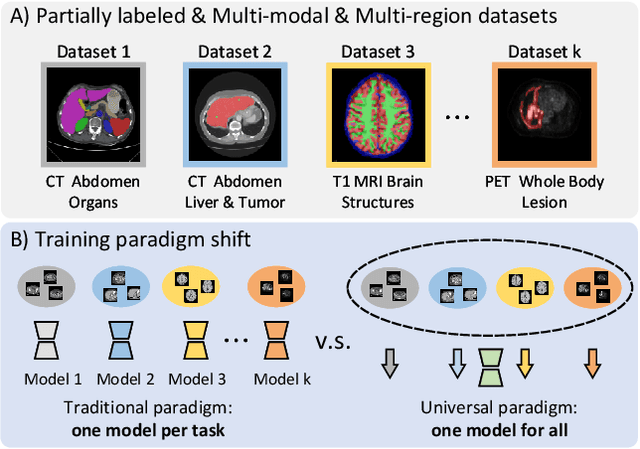
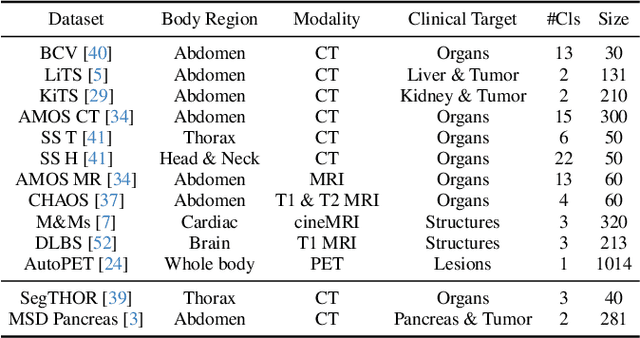
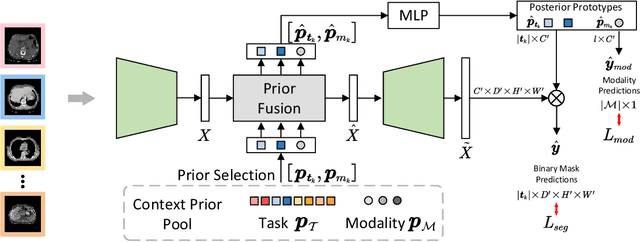
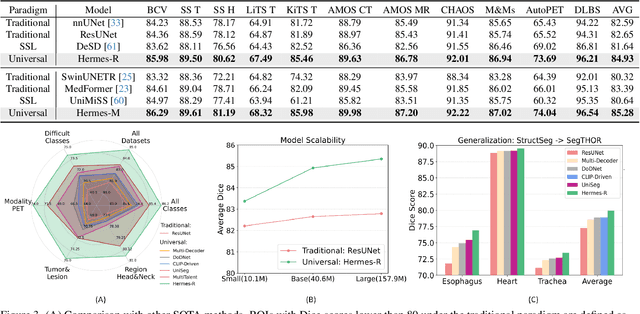
Abstract:A major enduring focus of clinical workflows is disease analytics and diagnosis, leading to medical imaging datasets where the modalities and annotations are strongly tied to specific clinical objectives. To date, building task-specific segmentation models is intuitive yet a restrictive approach, lacking insights gained from widespread imaging cohorts. Inspired by the training of medical residents, we explore universal medical image segmentation, whose goal is to learn from diverse medical imaging sources covering a range of clinical targets, body regions, and image modalities. Following this paradigm, we propose Hermes, a context prior learning approach that addresses the challenges related to the heterogeneity on data, modality, and annotations in the proposed universal paradigm. In a collection of seven diverse datasets, we demonstrate the appealing merits of the universal paradigm over the traditional task-specific training paradigm. By leveraging the synergy among various tasks, Hermes shows superior performance and model scalability. Our in-depth investigation on two additional datasets reveals Hermes' strong capabilities for transfer learning, incremental learning, and generalization to different downstream tasks. The code is available: https://github.com/yhygao/universal-medical-image-segmentation.
Steering Prototype with Prompt-tuning for Rehearsal-free Continual Learning
Mar 16, 2023



Abstract:Prototype, as a representation of class embeddings, has been explored to reduce memory footprint or mitigate forgetting for continual learning scenarios. However, prototype-based methods still suffer from abrupt performance deterioration due to semantic drift and prototype interference. In this study, we propose Contrastive Prototypical Prompt (CPP) and show that task-specific prompt-tuning, when optimized over a contrastive learning objective, can effectively address both obstacles and significantly improve the potency of prototypes. Our experiments demonstrate that CPP excels in four challenging class-incremental learning benchmarks, resulting in 4% to 6% absolute improvements over state-of-the-art methods. Moreover, CPP does not require a rehearsal buffer and it largely bridges the performance gap between continual learning and offline joint-learning, showcasing a promising design scheme for continual learning systems under a Transformer architecture.
 Add to Chrome
Add to Chrome Add to Firefox
Add to Firefox Add to Edge
Add to Edge